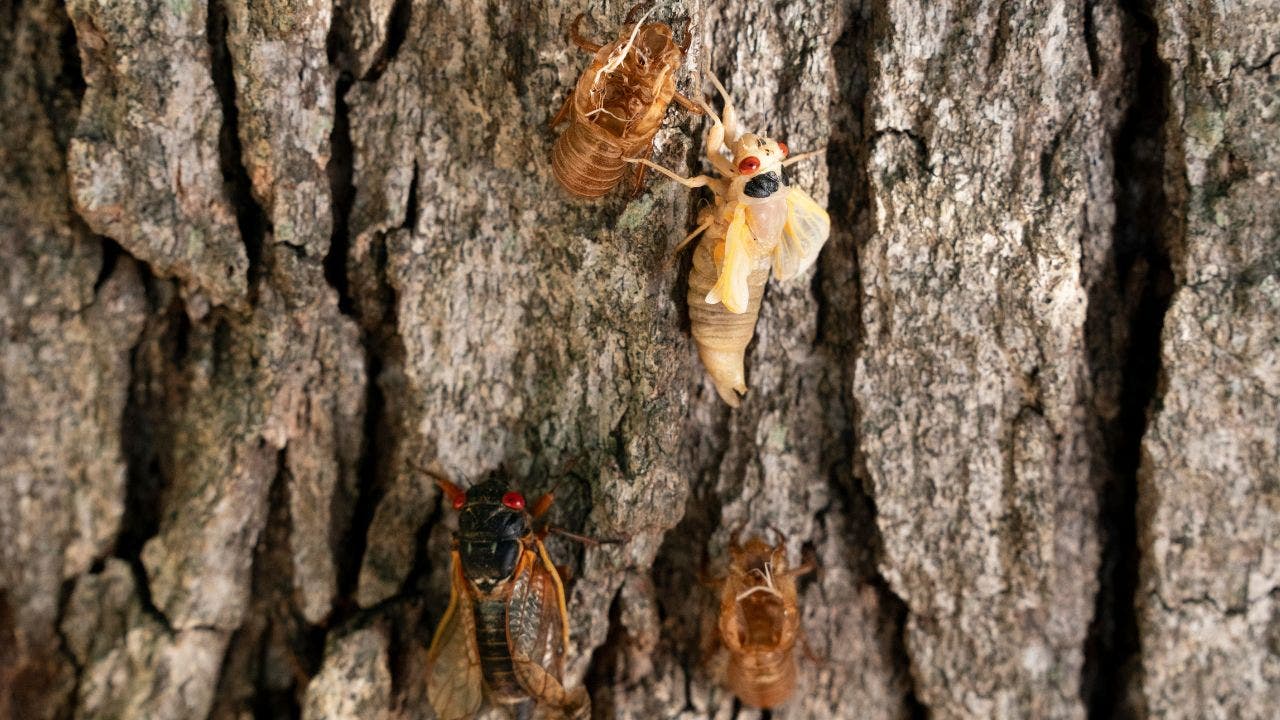The historic cicada invasion is upon us!
Noisy flying insects known as cicadas have begun emerging from the ground and have been spotted buzzing around North Carolina and South Carolina before they will eventually appear across 15 other states.
The one to two-inch-long bugs are rising from the soil and growing wings before they then start a frantic mating frenzy lasting several weeks.
Billions, if not trillions, of two groups of cicadas will appear in 17 U.S. states over the coming months in a rare natural phenomenon not seen since 1803.
CICADA INVASION: AN ‘AMAZING’ AMERICAN PHENOMENON AND BONANZA FOR ANGLERS

A Brood XIX adult cicada emerges from its exoskeleton at the University of North Carolina on May 1, 2024 in Chapel Hill, North Carolina. Billions of the flying insects will appear in 17 states this year. (Sean Rayford/Getty Images)
It is the first time in 221 years that two types of cicadas — brood XIX and XIII — have risen from the ground at the same time, back when Thomas Jefferson was president, and it is not expected to happen again until 2244.
The bugs possess sturdy bodies, bulging compounded red eyes and membranous wings with a three-inch wingspan.
The two broods together will span parts of 17 states: Alabama, Arkansas, Georgia, Iowa, Indiana, Illinois, Kentucky, Louisiana, Maryland, Missouri, Mississippi, North Carolina, Oklahoma, South Carolina, Tennessee, Virginia and Wisconsin, according to the United States Forest Service.
Newly released video shows swarms of cicadas climbing up a tree, while in other footage the insects can be seen flying under the lights of a canopy, swarming a nearby wall and crawling on the ground.
“It is a pretty amazing phenomenon, I mean, it’s unique,” Eric Benson, a professor emeritus and extension entomologist at Clemson University in South Carolina, told Fox News Digital last month.
“They’re one of the longest-lived insects that we know and the fact that a bug can be underground for 13 years or 17 years, and then almost at the exact same time, they all come out of the ground synchronized,” Benson said. “It’s amazing to me. It’s one of nature’s cooler phenomena in the world.”

A USDA Forest Service map showing cicada brood emergence from April to May 2024 in the eastern United States. The areas in red show where Brood XIII, a 17-year brood, is expected to emerge. The areas in blue show where Brood XIX, a 13-year brood, is expected to emerge. The area in yellow shows where these brood emergences are expected to overlap in Illinois. (USDA Forest Service graphic)
RARE BROODS OF CICADAS TO ARRIVE SOON: WHEN TO EXPECT THEM AND WHAT IT MEANS FOR YOU
There are around 190 species of cicadas all over the world, but only in the eastern United States can you find the periodical cicadas, which emerge every 13 or 17 years.
Cicadas are not harmful to humans, pets, household gardens or crops, the EPA says. They are also a valuable food source for birds and mammals.
According to one social media video, turkeys have been feasting on cicadas. The video, posted on X, shows a dead turkey with its crop cut open, revealing at least a dozen cicadas that the bird had been gobbling up.
“Even back in history, Native Americans ate cicadas because all of a sudden you’re provided with all this amazing protein falling in your lap,” Benson said.
The busiest period of activity for cicadas is from now through early June, and they usually appear after a nice soaking of rain when the temperature of the ground hits 64 degrees, Benson explained.
“They’ll crawl up on a surface, usually the trunk of a tree, or it could be on the side of your house, a car, a fence or whatever. They’re insects, so they have to shed their skin to get to the next stage, and they will go through their final molt where they pull out of their immature skin, and they will be in their adult skin, which will have wings,” Benson said.
“They’ll molt, expand their wings, harden up and when they’re ready they’ll fly up into the trees.”
He said that eventually the cicadas will mate in a noisy fashion and then the females will deposit their eggs onto tree branches. They will hatch and fall into the ground where they will stay for the next 13 or 17 years before the process repeats.
So many cicadas will make noise at once in some places that sound levels might reach upward of 90 to 120 decibels, equivalent to a gas-powered lawnmower or motorcycle, the U.S. Forest Service says.
Meanwhile, the mating cicadas will die off and homeowners will be left hoping that the dead carcasses do not land in their gardens as they can smell badly if they die in large numbers together.

Several brood XIX cicadas crawl on the ground at the University of North Carolina on May 1, 2024. Billions of two groups of cicadas are set to appear in 17 U.S. states in a rare natural phenomenon not seen since 1803. (Sean Rayford/Getty Images)
Females laying their eggs on small tree branches can harm young trees and the EPA advises covering maturing saplings in mesh or netting to keep the insects out.
Experts also advise homeowners to cover pools, patio furniture or similar items from cicada or their droppings when they are active.
CLICK HERE TO GET THE FOX NEWS APP
Brood XIII cicadas appear on a 17-year cycle, and are restricted mostly to northern Illinois, eastern Iowa, southern Wisconsin and a few counties in extreme northwestern Indiana, according to entomologist Floyd Shockley of the Smithsonian Institution’s National Museum of Natural History in Washington.
Brood XIX emerges on a slightly shorter 13-year cycle, and are widely distributed from Alabama, Arkansas, Georgia, Indiana, Illinois, Kentucky, Louisiana, Maryland, Missouri, Mississippi, North Carolina, Oklahoma, South Carolina, Tennessee and Virginia – a total of 15 states, according to Shockley. The two broods together span parts of 17 states.
These two broods overlap only in a small area in central Illinois and sometimes in Indiana. They are close enough potentially to have some interbreeding between broods.

A Brood XIX cicada crosses a brick path on campus at the University of North Carolina on May 1, 2024. (Sean Rayford/Getty Images)







